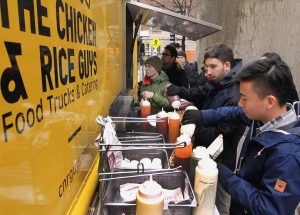Boston, you’re a big city with a strange accent, why haven’t you figured out restaurant inspection disclosure until now?
 Regardless, Boston plans to soon start assigning letter grades to publicly rate the cleanliness and food safety practices for all restaurants and other food-service vendors in the city, giving diners a visible new tool to confidently choose where to eat.
Regardless, Boston plans to soon start assigning letter grades to publicly rate the cleanliness and food safety practices for all restaurants and other food-service vendors in the city, giving diners a visible new tool to confidently choose where to eat.
Officials hope to launch a pilot version of the grading system in early January. For the first year, restaurant letter grades — either an A, B, or C — would be posted online only.
But after that, as long as the program’s roll-out goes smoothly, the grades would be posted in storefront windows of every restaurant across Boston, resembling systems New York and other cities have been using for years.
“We want to make it as simple as we can for people to understand the health conditions at our restaurants,” said William Christopher, head of Boston’s Inspectional Services Department, which will oversee the program.
Christopher said he went to New York City recently to review that city’s program, which began in 2010. He also has researched grading systems in other cities, including Los Angeles, which has been issuing grades since 1997.
Locally, Newton launched a similar restaurant-rating program last month.
A Globe report in May detailed how a review by city inspectors 2014 found serious health code violations at nearly half of Boston’s food service vendors, including restaurants, food trucks, and cafeterias. However, Christopher said the city had been considering the grading system idea prior to that report.
Christopher cited how officials in other cities have said their grading systems have spurred improvements: reducing health violations, improving public awareness about food safety, and even boosting business for restaurants, by increasing competition for owners to keep cleaner stores.
“Everyone wants to be an A rating, so it motivates restaurateurs,” Christopher said in an interview Monday.
But such systems have also faced criticism. Some have questioned assertions that the grading systems lead to improved conditions, and others have accused the ratings of being arbitrary.
 Bob Luz, president and chief executive of the Massachusetts Restaurant Association, reacted cautiously to the new initiative. He said such rating systems can oversimplify the results of restaurant inspections, which he noted the City of Boston already makes available online in more detail.
Bob Luz, president and chief executive of the Massachusetts Restaurant Association, reacted cautiously to the new initiative. He said such rating systems can oversimplify the results of restaurant inspections, which he noted the City of Boston already makes available online in more detail.
And the restaurant association thingy would be expected to say nothing else, using talking points from the National Restaurant Association. Go back and look at the crap that was hurled when Toronto adopted a red-yellow-green system in 2001 (or 02?).
I prepared a court brief on why the system was valid, but it never went to court because once a system is introduced, it’s hard to get rid of.
We’ve spent the last 15 years trying to determine the most effective disclosure systems.
Restaurant association types could do the same.
 This idea has risk written all over it.
This idea has risk written all over it.










